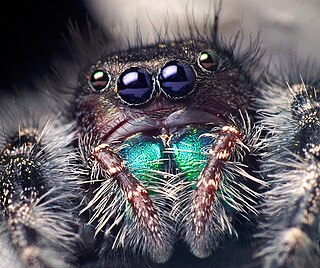
Phidippus is a genus in the family Salticidae. Some of the largest jumping spiders inhabit this genus, and many species are characterized by their brilliant, iridescent green chelicerae. Phidippus is distributed almost exclusively in North America, with the exception of two exported species. As of January 2021, there were about 80 described species in the genus. Species previously described in Phidippus which are found in India and Bangladesh do not belong in this genus.

Gongylonema is a genus of thread-like nematode that was described by Molin in 1857. It is the only currently valid genus in the family Gongylonematidae, though the mysterious Spiruroides – usually placed in the Subuluridae, which are not closely related to Gongylonema among the Spiruria – might actually belong here. They are parasites of birds and mammals, transmitted by insects. Some 38 species are known, about 12 of which have been recorded in Europe.

Mesostigmata is an order of mites belonging to the Parasitiformes. Unlike most members of that group, many of these mites are not parasitic but free-living and predatory. They can be recognized by the single pair of spiracles positioned laterally on the body.

The Laelapidae are a family of mites in the order Mesostigmata. The family is also referred to in the literature as Laelaptidae, which may be the correct spelling.
Epiperipatus is a genus of Neotropical velvet worms in the Peripatidae family.
Otopheidomenidae is a family of mites in the order Mesostigmata.

Rhinonyssidae is a family of mites in the order Mesostigmata.

Ptilonyssus is a genus of mites in the family Rhinonyssidae. There are more than 20 described species in Ptilonyssus.
Ixodorhynchidae is a small family of mites in the order Mesostigmata.
Uroseius is a genus of mites in the family Trachytidae.

Orthohalarachne attenuata is a species of mite normally found in the nasal passages of fur seals, sea lions, and walruses. In seals, the mites can be both prevalent and abundant. Although clinical observations and gross examination indicate that O. attenuata parasitization alone is not serious, some erosion and inflammation of the nasal turbinates and nasopharynx in seals has been observed in histological sections. If concomitant parasitization with O. attenuata and O. diminuta occurs, alveolar emphysema and more serious ailments can threaten the life of the mammal.
Sertularella is a genus of hydroids in the family Sertulariidae.

Halopterididae is a family of hydrozoans.

Pseudothurmannia is a genus of extinct cephalopods belonging to the subclass Ammonoidea and included in the family Crioceratitidae of the ammonitid superfamily Ancylocerataceae. These fast-moving nektonic carnivores lived in the Cretaceous period, from Hauterivian age to Barremian age.

Boreus is the most diverse of three genera of insects in the family Boreidae. They are commonly known as winter scorpionflies due to their close relation to the true scorpionflies and preference for cold habitats.
Heteropogon is a genus of robber flies in the family Asilidae. There are at least 60 described species in Heteropogon.

Sennertia is a genus of mites in the Chaetodactylidae family. There are more than 70 species. Some of these mites are parasites or commensals of bees, but the presence in some bees of specialized structures for carrying mites (acarinarium) indicates the mutualistic nature of the relationship of some species. Most species of the genus Sennertia settle on adult bees as heteromorphic deutonymphs, but the species Sennertia vaga has no deutonymph and settle on adult bees in the eating adult stages. Reproduction and feeding occurs during resettlement. Most species occur on small carpenter bees (Ceratina) and large carpenter bees (Xylocopa) of the family Apidae. A few species are associated with Centris (Paracentris) in the Neotropics.
Gonothyraea is a genus of cnidarians belonging to the family Campanulariidae.











